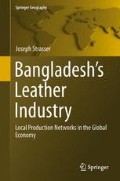Abstract
The last section synthesises core results by relating to the research questions this work has drawn on. It gives account of what has been brought to light, shows where more research is needed and suggests what lessons can be learned. It concludes that the discussion of the research questions revealed a number of specific phenomena and strongly interwoven dynamics in Bangladesh’s leather industry that ensure price competitiveness on the international market but impinge on sustained competitiveness. Other countries’ strategies to improve the competitiveness of MSME suppliers cannot be taken prescriptively. The author suggests an individual but holistic approach that takes into account the role of informal institutions for the industry’s competitiveness. Much of the future of Bangladesh’s leather industry depends on the relocation of the tanning estate to Hemayetpur/Savar.
Access this chapter
Tax calculation will be finalised at checkout
Purchases are for personal use only
References
Alsayyad, N., & Roy, A. (2004). Urban informality: Crossing borders. In A. Roy & N. Alsayyad (Eds.), Urban informality: Transnational perspectives from the middle east, latin America, and South Asia. Oxford: Lexington Books.
Ballard, R. (2001). A preliminary study on the bovine leather value chain in South Africa. CSDS Research Report No. 40, University of Natal, Durban.
Bettiol, M., De Marchi, V., Di Maria, E., & Micelli, S. (2011). Economic, social and environmental upgrading in value chains: Social entrepreneurship and the role of emerging economy lead firms. School of Environment and Development/University of Manchester, Working Paper 4, Manchester.
Coe, N., Dicken, P., & Hess, M. (2008). Global production networks: Realizing the potential. Journal of Economic Geography, 8(3), 271–295.
Dietsche, C. (2011). Umweltgovernance in globalen Wertschöpfungsketten: Umweltschutz und Qualitätssicherung im Handel mit tropischen Garnelen und Ledererzeugnissen. Lit Verlag, Münster.
Gereffi, G. (2005). The global economy: Organisation, governance and development. In N. J. Smelser & R. Swedberg (Eds.), Handbook of economic sociology (2nd ed., pp. 160–182). Princeton, NJ: Princeton University Press and Russell Sage Foundation.
Jabbar, M. A., Kiruthu, S., Gebremedhin, B., & Ehui, S. (2002). Essential actions to meet quality requirements of hides, skins and semi-processed leather from Africa. Retrieved from: http://www.unido.org/fileadmin/import/10197_Jabbar.2.pdf. Accessed July 16, 2014.
Steer, L., & Sen, K. (2010). Formal and informal institutions in a transition economy: The case of Vietnam. World Development, 38(11), 1603–1615.
Tewari, M., & Pillai, P. (2005). Global standards and the dynamics of environmental compliance in India’s leather industry. Oxford Development Studies, 33(2), 245–267.
Triple Line Consulting Ltd. (2002). Study 1: Market requirements for importers of African hides and skins. The Hides, Skins and leather sector in Africa—Essential actions to meet quality requirements of importers. Retrieved from: http://www.unido.org/fileadmin/import/10211_triplebottom.2.pdf. Accessed June 9, 2014.
Wayua, F. O., & Kagunyu, A. (2012). Constraints and opportunities in the hides and skins value chain in pastoral areas of northern Kenya. Livestock Research for Rural Development 24(8). Retrieved from: http://www.lrrd.org/lrrd24/8/wayu24135.htm. Accessed July 17, 2014.
Author information
Authors and Affiliations
Corresponding author
Rights and permissions
Copyright information
© 2015 Springer International Publishing Switzerland
About this chapter
Cite this chapter
Strasser, J. (2015). Conclusion. In: Bangladesh's Leather Industry. Springer Geography. Springer, Cham. https://doi.org/10.1007/978-3-319-22548-7_6
Download citation
DOI: https://doi.org/10.1007/978-3-319-22548-7_6
Published:
Publisher Name: Springer, Cham
Print ISBN: 978-3-319-22547-0
Online ISBN: 978-3-319-22548-7
eBook Packages: Earth and Environmental ScienceEarth and Environmental Science (R0)

